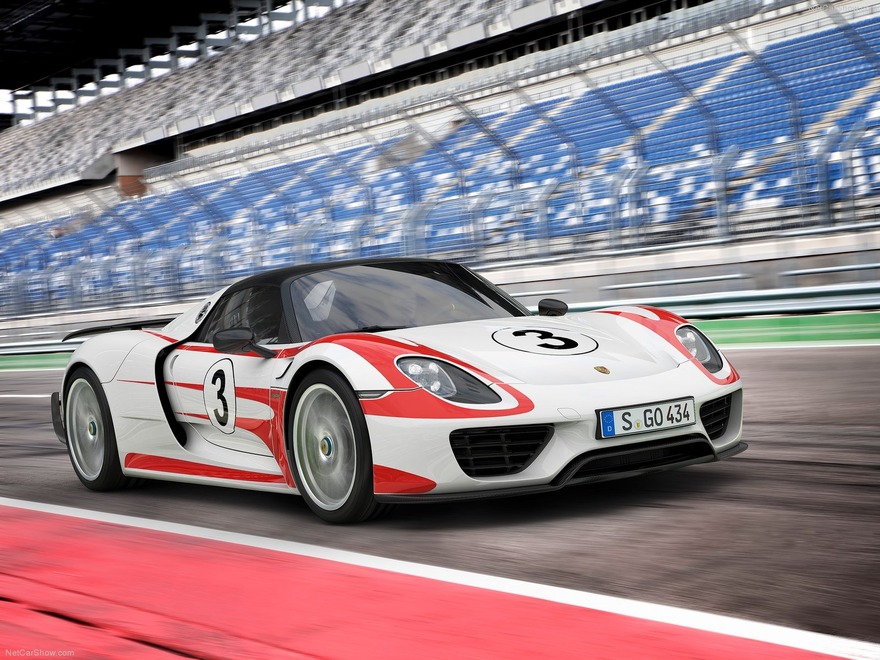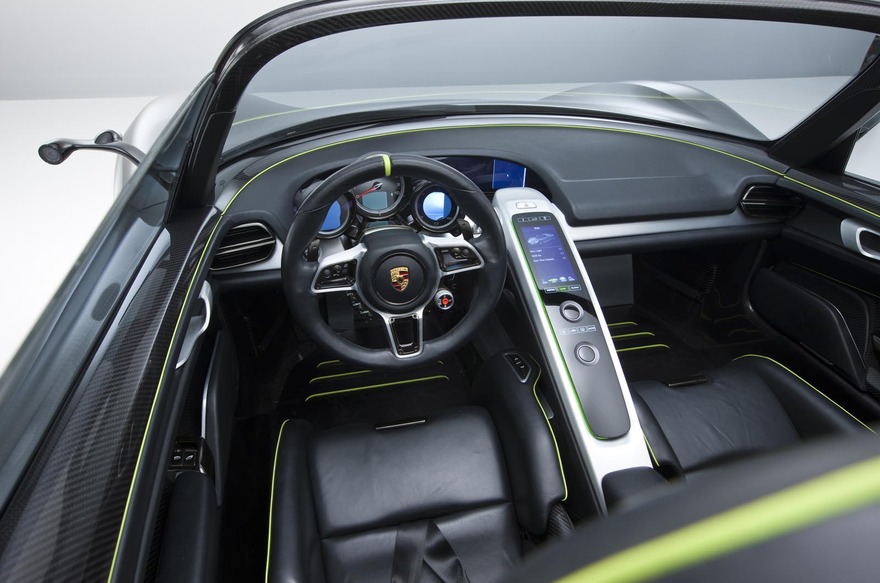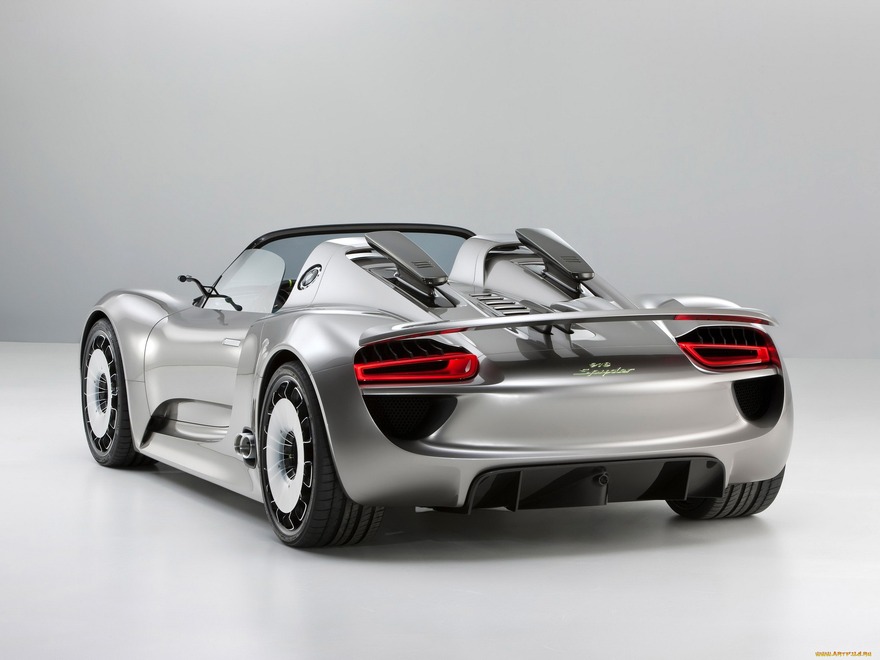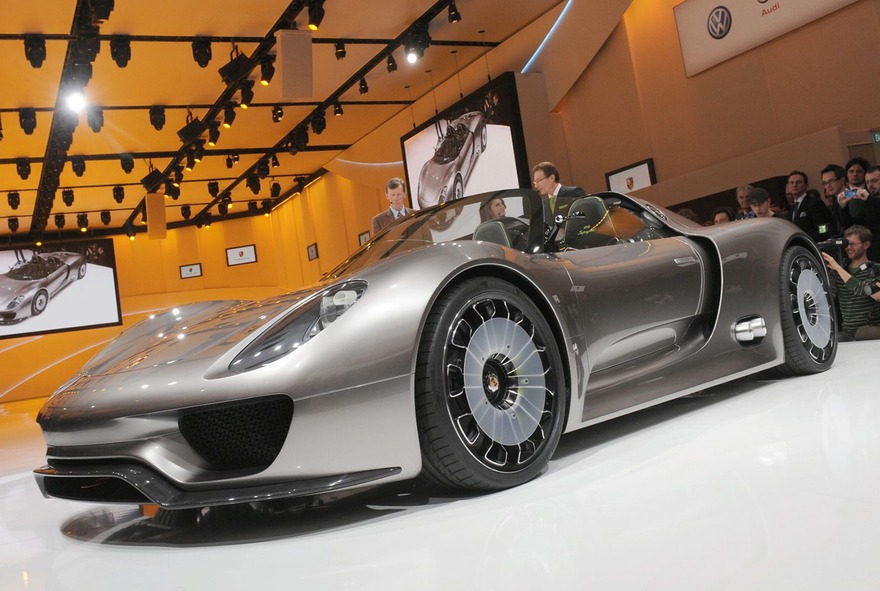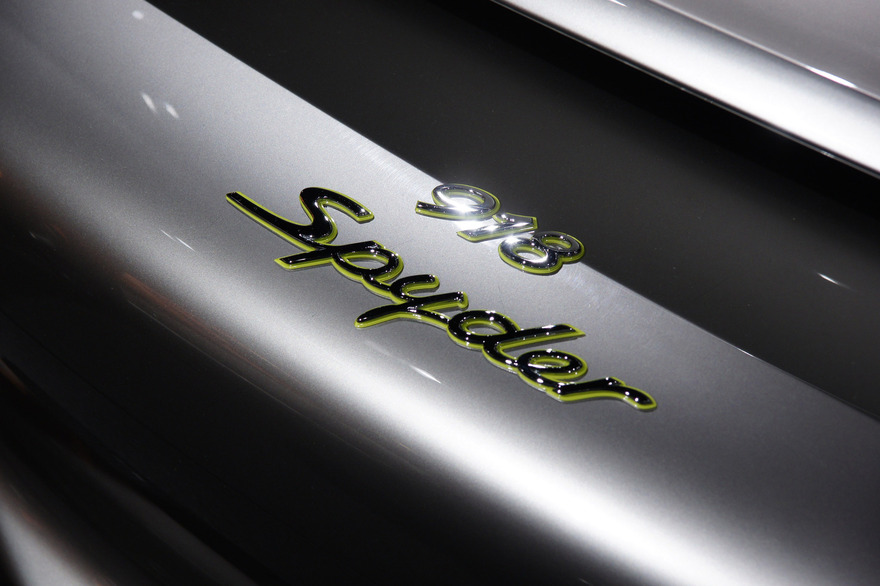Porsche 918 Spyder Hybrid is one of the most legendary car in Porsche model line: the fastest, the most powerful and almost the most expensive in the history of this great company. This supercar can be called a continuation of the previous flagship — Carrera GT roadster.
The car created by a talented Porsche Motorsport engineers, was first introduced at the Frankfurt Motor Show in 2013 as a car of 2015 model year. Production of the Porsche 918 Spyder symbolically launched September 18, 2013 and is scheduled to end in February 2015. By the way, the number of vehicles to be issued is also symbolic — exactly 918.
ENGINE
Double-seated Porsche 918 Spyder roadster has the following dimensions: 464.3 x 194 x 116.7 cm. Wheelbase length is 273 cm. Weight is about 1674 kg. Supercar is equipped with three engines — the petrol engine and two electric motors. The main V8 petrol engine (with direct fuel injection and with 32 valves) has 4593 cc of the volume and outputs 608 hp at 8700 rev / min.
Together with the 286 hp of the electric motors they give in total 887 hp. In this case, the torque ranges from 917 to 1280 Nm.
Rechargeable lithium-ion battery with a voltage of 385 V and the capacity of 6.8 kW / h and a mass of 138 kg is able to give a peak of up to 230 kW at 430 V and 606 A. The engine made of aluminum weighs only 135 kg, has a thin wall cylinder block and a compression ratio of 13.5: 1, is equipped with a direct injection (pressure up to 200 bar) and the mechanism of variable valve timing on the intake (25º) and release (27º).
The engine has the highest output — 132 hp from every liter of the volume, but it has only the common concept with a RS Spyder prototype engine. The collapse of the units is at a 90 degrees angle, a «flat» crankshaft (cervical titanium rods separated by 180º), the dry sump lubrication system. Crankshaft weighs 13 kg — hollow with oil-cooling route for connecting rod bearings. Intake manifold routed directly inside the frame of the carrier module, each block has its individual throttle. Rear traction motor acts as a starter, which is almost always in motion, so for the mode start/stop the position of the pistons is not taken into account.
The hybrid power plant is configured with taking in account the location of the V8 engine and transmission: rear traction motor is sandwiched between the engine and transmission. The front wheels are rotated only by an electric motor, this meaning hides under ePTM abbreviation. The control system uses CAN-bus connecting 55 electronic control units.
Rear 115-kilowatt synchronous motor with a water-cooled stator is connected to transmission with the dry clutch. Air turbine is added to minimize heat. Robotized dual-clutch PDK gearbox is installed in a special way: it is placed upside down to make lower the center of gravity. The front motor reaches 16 000 rpm, which corresponds to a speed of 265 km / h. After this speed is exceeded the clutch opens, making super-hybrid rear wheel driven.
Spyder has five independent cooling circuits with seven heat exchangers. Working temperature for the power electronics circuit is 85 ºC, for engine oil is 150ºC.
Ferrari LaFerrari (963 hp) and McLaren P1 (916 hp) hybrid supercars contributed into Porsche 918 Spyder popularity. Porsche Spyder is more economical and technological supercar, superior in speed in the corners of these competitors. This has been achieved through active aerodynamics Porsche Active Aerodynamic (PAA), all wheels steering chassis (rear wheels can rotate up to three degrees), PASM adaptive suspension and low center of gravity, which is located just above the wheel hubs.
SUSPENSION
The Spyder chassis consists of two suspensions: front with double arms, back with multi arms with electromechanical steering system with a 3º of maximum angle. So the rear wheels are steered to the opposite side from the front wheels(at speeds up to 50 km / h, improving maneuverability or to the same — this improves stability on high speeds. The clearance is quite small — about 10 cm.
The monocoque and its fasteners are made of carbon fiber (as in «Formula 1» and Le Mans prototypes). Rear engine mounting pads are produced by the Carbotech an Austrian company which used Porsche technical documentation. Aluminum levers are connected to the monocoque using rod end joints, as is implemented in motorsports, instead of usual rubber bushes. As a result the stiffness of the whole structure with an open roof is comparable to the body of the very stiff Cayman — it is 40 000 N • m. Energy recovery system works during braking
The car is equipped with well-engineered electronics: manual mode of the gearbox gets a deceleration rate and determines the degree of complexity of the upcoming curve and, consequently selects the necessary gear. On small hills and fast curves with negative road angle the 918 Spyder is a stable and allows you to control the grip before stabilization system is activated. Sharp steering with two and a quarter turns from left lock to right lock is very responsive. Wheel alignment and geometry of the steering system are perfectly balanced, the steering drive of the rear wheels is set very good.
The front and rear brakes are disc, front and rear rotors are perforated, brake pads are made of carbon-ceramic, which is almost impossible to overheat. Wheels are wrapped in road “slicks” Michelin Pilot Sport Cup 2 with specially chosen for Porsche compound with front dimension 265/35 ZR20 and rear — 325/30 ZR21. Still, manufacturers warn in advance that even road “slick” with tiny protector can cause understeering and aquaplaning. There are no winter tires for Porsche 918, so Spyder — a car exclusively for summer travel.
OPERATION MODES
In Porshe 918 Spyder, the algorithm of the active aerodynamic elements (PAA) varies depending on the selected mode, there are five modes in total.
1 E-Power — an all-electric mode. In this mode, the Spyder is able to travel up to 30 km at speeds up to 150 km / h and accelerate from 0 to 100 km / h in 6 seconds.
2. Hybrid — mode that enables the V8 engine. This mode is considered optimal for everyday driving — an electronic intelligence itself determines when to start the engine when accelerating or to recharge the batteries or disable it to save fuel.
When you select E-Power or Hybrid mode the rear spoiler, the air ducts which bring the air to the rear diffuser in the bottom of the car and the ducts under the headlights close to reduce the air drag.
3. Sport Hybrid — V8 engine is enabled for a permanent work (function Boost), moreover, an additional spoiler remains elevated, but with the smaller angle. Holes under the headlights remain opened for better cooling of the power plant.
4. Race-Hybrid — stabilization system is turned off, all three motors are reaching their best performance. The batteries charge is more intense, and works similar to KERS system in Formula 1 cars.
5. Hot Lap — the most extreme mode is designed for maximum attack when all available resources fully apply their potential. Petrol engine works in an evanescent mode, absolutely without waste of energy to charge. Electric motors give their power during acceleration. Rear spoiler is set to maximum angle that improves downforce and proper grip. Open ducts at the bottom suck the air, forming a kind of air cushion that prevents the turbulence underneath.
SPEED AND CHARGING
Supercar has a four-wheel drive and is equipped with a 7-speed robotized gearbox (PDK). The maximum possible speed — 345 km / h, the maximum speed using the electric power — 150 km / h, range is only 30 km. Acceleration from 0 to 100 km / h takes just 2.6 seconds. Average fuel consumption is about 3 liters per 100 kilometers, the fuel tank holds 70 liters of petrol.
Charge of the battery can be done using a household power socket (220V) in 4 hours. If a stationary charger issuing a high DC voltage is available, the charging time will be reduced to half an hour.
As for the racing mode, the battery is never actually empty: recovery is activated when there remain 30–50% of charge. The system is activated when the accelerator is pressed by three-quarters — the computer opens the throttle fully, but a quarter of the power is used to charge the battery, so to recharge the battery no more than 4.5 minutes is needed.
EDITION «Weissach»
When you purchase a Porshe 918 Spyder in Weissach Package it will be equipped with lightweight ceramic wheel bearings and springs without additional damper. Brake system is with an electric pump hydraulic system. Rear stabilizer is made of carbon fiber, which makes it 1.3 kg lighter than the usual one. Of course it goes without radio, air conditioner and some parts of interior door panels.
Weissach Package is made for lightweight: composite rear stabilizer and paddle trigger (saves 200 gr). Wheels are made of magnesium alloy and they are so weightless that they can be raised with one finger. This package also includes additional aerodynamic elements, six-point safety belts, and choice of different films instead of paint to lighten the car even more.
However, the increase in the dynamics of small: Weissach Package is 0.1second faster on acceleration to 200 km / h and the whole second at acceleration to 300 km\h, insulation is worse and lightweight springs are stiffer. But the downforce is higher (thanks to additional side flaps on the rear bumper) and the time on the track is better.
Porsche 918 Spyder weights 1 675 kg (its distribution is 43:57 in favor of the rear axle), and with a Weissach package — 1640, but for a 35 kilograms of weight loss you will have to pay much.
AERODYNAMICS
Spyder always has a downforce equivalent to more than 132 kg at 300 km / h. Drag coefficient depends on the spoiler vsettings: 0.36 for the standard car with deactivated spoiler and 0.41 with a raised. Weissach Package makes Spyder a little bit more effective: Cx of 0.35 and 0.40, respectively.
Rear spoiler experiences heavy loads, has two modes in the upper position (standard and with the increased on 12º angle), it is driven by a separate hydraulic system. The front air ducts are closed by motorized blinds to reduce air resistance, when additional cooling is not needed. When the downforce is at maximum flexible curtains underneath go inside, diverting part of the air flow to the brakes.
ECOLOGY
In the emissions calculations even petrol fumes entering the atmosphere when the engine is stopped were taken into account by manufacturers, so the fuel tank has always extra pressure. To open the fuel tank, it is necessary to relieve the pressure by pressing a special key — fuel vapors will be absorbed by the charcoal filter. Compact exhaust system is made of Inconel low resistance and weighs 29 kg.
Emission meets the Euro 5 requirements, fuel tank capacity is 70 liters of petrol. Thanks to the electric power Porsche consumes just three liters per 100 km by NEDC standard and has only 70 g / km of CO2 emissions. As for fuel economy, the Porsche 918 Spyder hybrid mode consumes on average 3.3 liters of gasoline per 100 kilometers. Ferrari and McLaren are very far away from such figures.
DESIGN AND INTERIOR
Porsche 918 Spyder has a unique design, where family style brand is recognizable. Smooth and quiet lines are arranged in a dynamic style of a racing RS Spyder LMP2.
The design is very delightful and details add more. Two removable weightless carbon covers, folding into the trunk can save the interior from the rain. The trunk, by the way, is very small — just 100 liters. LED lights with adjustable power — 18 watts in normal mode and 25 W in Sport and Race — weight less than 1 kg each.
Door handles are hidden, to get inside the car you need to overcome high threshold. Seats, according to tradition, are placed deep in the cabin. You can only adjust the seat vertically and longitudinally — it is a bit unusual. Inside the space is not too much. Steering wheel is telescopic adjustable. The wheel and seats are decorated with light refractory cloth and Alcantara. Also leather is used in decoration, but carbon fiber dominates among all materials, even the exterior mirror housings and brake pedal are made of it. Even if something seems to be done of aluminum it is galvanized carbon fiber, only frame of the steering steering wheel and decoration pads are made of metal.
Unusual center console is stretched almost across the entire space. After ignition key is turned touch screens and buttons begin to glow. The dashboard has a recognizable style: the three major instruments. On a small stylish multifunctional steering wheel there is a Map Switch which switches between modes, buttons and gearshift paddles. Multimedia system has a vast number of features and it is possible to connect your smartphone to gain control over functions. All buttons are very easy to find — everything is done in convenient way: you can adjust stabilization system, shock absorbers or to raise the front in one or two button clicks.
Key responsible for clearance adjustment is located next to the suspension stiffness control button. The main information display has a touch-screen, rearview camera makes parking easier, and a special deflector which is mounted on the frame of the windshield makes driving without the roof more comfortable.
The basic package includes six airbags, outstanding climate control, audio system with 11 speakers and a 7-inch touchscreen ion the center console, and for extra fee — audio Burmester, and air lifters to help front suspension pass through entry ramps and «speed bumps».
PRICE
Exclusive and compact car from Porsche is truly expensive. The starting price is 991,300 euros (more than 40 million rubles) for the usual Spyder, and is 1,082,300 euros for Weissach edition. In Europe, the basic model is starts from 645,000 euros.
Additional costs will follow if you choose a leather seat trim — 23 000 euros, a unique metallic paint — 47 600 euros, ultra-fast charger, able to charge the battery in a half an hour — 20 230 euros. For Weissach edition you have to pay more about 80 000 euro (or you can buy the basic version of the Porsche 911 Carrera).
The quota for Russia is seven cars, and one of them is already sold! Porsche received a prepayment for first hybrid supercar, this was announced in September 2013 in Frankfurt by Thomas Sterzel, CEO of the Russian Porsche office to the «Motor» magazine. It will take around a year and a half to deliver the car to the customer.
However, the Russians have not the highest cost — Chinese market for the base version will be priced from 13 388 000 yuan (about 1 623 000 euros), and with Weissach package — altogether 14 635 000 yuan, (about 1 775 000 euros.)
RECORD Nordschleife Nurburgring
During Porsche 918 Spyder journalist test-drive Yuri Uryukov from the “Klaxon” magazine asked Walter Röhrl, the double champion about difficulties in the final tuning of the car
Walter Röhrl: «It is not a problem to put ten different engines under the hood. More difficult is to coordinate their work. For example, during first tests front wheels were rotating faster than rear ones. As a result, engines are controlled by more than fifty electronic components, so electric motor is not our eco-friendly cover for the environmentalists. Without the hybrid drive, we would not be able to put the Nurburgring Nordschleife record. We tried but the result was ten seconds worse. »
Record in the Nordschleife is 6:57 seconds now. Marc Lieb set it in Spyder Weissach Edition. Timo Klyuk, Porsche test pilot, said that if they were allowed to risk, they could pass the Nordschleife in 6:53 sec.
Summary. According to Richard Atwood words, winner of Le Mans in 1970, driving the Porsche 917 prototype, — beloved car for racer is one that is a second faster than others and makes the job easier. Probably only the real racer can appreciate the Spyder. Spyder’s handling is very similar to a racing car, as it may be permitted to road legal cars. Sound and comfort can be comparable with an aircraft: noisy roar of motors is very similar to the sound of jet engines. Manufacturers assume that most Spyders will be put to sports cars fans collections, and only a few of them will actually race on asphalt tracks.



